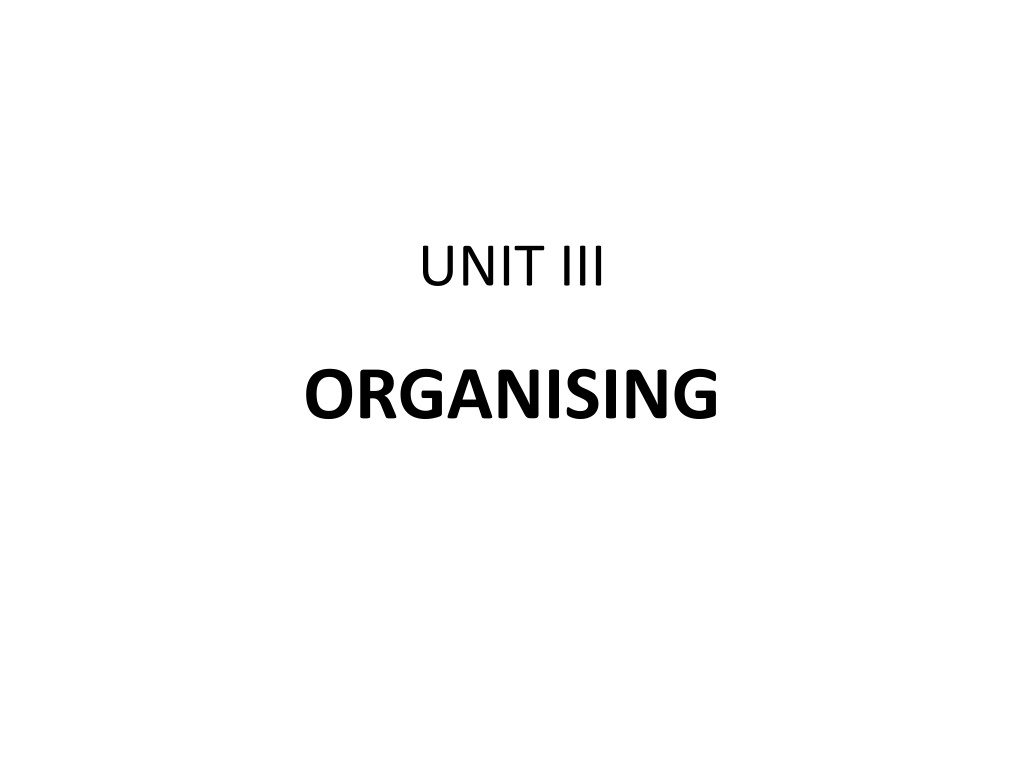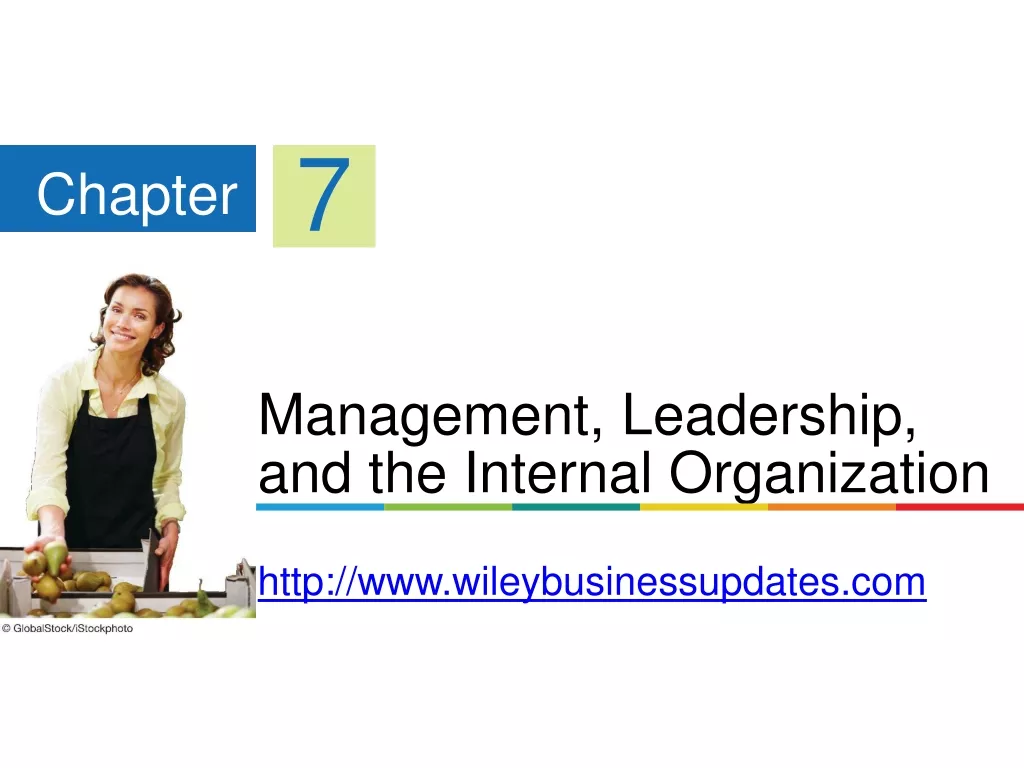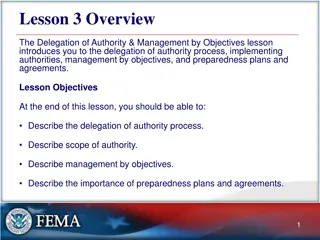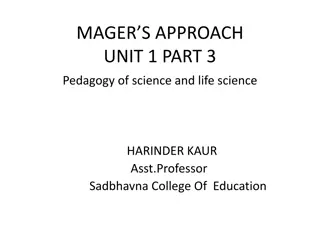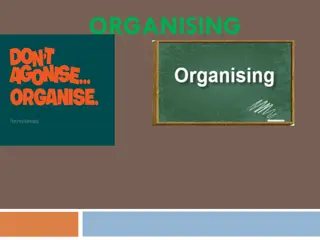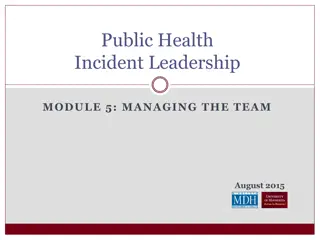Importance and Objectives of Organising in Management
Organising in management is the process of determining activities, grouping them efficiently, and establishing clear authority relationships. It facilitates administration, promotes growth, ensures coordination, enhances productivity, and fosters creative thinking. The objectives include effective management, maximizing production, sustaining growth, employee cooperation, and discharging social responsibility.
Download Presentation

Please find below an Image/Link to download the presentation.
The content on the website is provided AS IS for your information and personal use only. It may not be sold, licensed, or shared on other websites without obtaining consent from the author.If you encounter any issues during the download, it is possible that the publisher has removed the file from their server.
You are allowed to download the files provided on this website for personal or commercial use, subject to the condition that they are used lawfully. All files are the property of their respective owners.
The content on the website is provided AS IS for your information and personal use only. It may not be sold, licensed, or shared on other websites without obtaining consent from the author.
E N D
Presentation Transcript
UNIT III ORGANISING
MEANING AND DEFINITION Organizing is the process of determining the total activities to achieve a given objective, grouping and assigning of activities delegating them authority necessary to perform the activities assigned and established among different positions in the organization. According to George Terry Organising is the establishing of effective authority relationships among selected work, persons, and work places in order for the group to work together efficiently . to individuals,
IMPORTANCE OF ORGANISING Facilitates administration: The function of organizing is required for the performance of other functions of management. Inadequate and unscientific methods may result in duplication of work and efforts. Promotes growth and diversification: Organising helps in keeping the various activities under control and increases the capacity of the enterprises to undertake more activities. Fosters co-ordination: It is an important means of bringing co-ordination among the various departments of the enterprise. It creates clear cut relationship between the departments and helps in laying down balanced emphasis on various activities. Provides for optimum use of technological innovation: Organising and organisation as such should be flexible to give adequate scope for the improvements in technology. Enhances the productivity: The productivity is enhanced through avoidance of duplication of activities, confusion as well as wastage of efforts. Ensures optimum use of human resources: Sound organisation ensures that every individual is placed on the job for which he is best suited. This helps in the better adjustment of individuals working in the organisation. Fosters constructive and creative thinking: Sound organisation stimulates independent, creative thinking and a spirit of initiative through a well-defined areas of work. Such environment in the enterprise helps in achieving the organisational goals and higher profits. Provides ample scope for training and development: Effective organisation facilitates delegation of authority which is necessary device for training and development of the personnel. Prevents growth of corruption, laggards etc: Unsound organisation becomes the breeding ground of dishonesty.
OBJECTIVES OF ORGANISING Effective management of the enterprise: It is the effective organisation that ensures proper balance between authority and responsibility. It achieves a clear line of communication and defines the area of work. Maximum production at minimum cost: The activities are allotted according to the principle of division of labor. Efficient organizing encourages every employee to make his best contribution in raising output. Sustained growth and diversification: Organisation plays an important role in expanding the activities of an enterprise. Execution of policies in an organisation builds up the necessary capacity and confidence in undertaking the bigger activities. Co-operation of employees: The organisational structure will succeed only when employees co-operate in the work. The management introduces various schemes and also gives monetary and other benefits to the employees so that they work in a team spirit. Discharging social responsibility: Social obligation is an important objective of building up sound organisation. The service motto cannot be realized without a well-knitted organisation structure
PRINCIPLES OF ORGANISATION Division of work: It is an established fact that group of individuals can secure better results by having division of work. While designing an organisation we should aim at making suitable grouping of activities. This is also called as principle of specialisation. Attention of objectives: The objectives of an organisation play an important role in determining the type of structure which should be developed. Clearly defined objectives facilitate grouping of activities, consequently effective co-ordination. Span of management: Span of management refers to the number of sub-ordinates reporting directly to an executive. It is an established fact that the more number of subordinates, tends to make more difficult to supervise and co-ordinate them effectively. Unity of command: This principle facilitates consistency in directing, co-ordinating and controlling to achieve the end objectives. Flexibility: Every organisation is a living entity in a living environment which is fast changing. As such there must be sufficient room for changing and modifying the structure in the light of environmental changes. Proper balance: It is important to keep various segments or departments of an organisation in balance. The problem of balance basically arises when an activity is divided into smaller segments. The problems also crop up with the growth of an organisation in its size and functioning. Management by exception: It is a fundamental principle which makes the organisation effective in its true sense. This principle signifies that problems of unusual nature only should be referred upwards and decided by the higher level executives in the managerial hierarchy, whereas the usual and routine problems should be passed on to the lower levels and resolve them. delegation of authority and
PRINCIPLES Decentralisation: This principle is of great significance to big organisation. Decentralisation implies selective dispersal of authority to help departments and units to run effectively and efficiently without frequent interruptions from the top of the enterprise. Departmentation: It is a process of grouping activities into units for the purposes of administration. The main advantage of departmentation is that it enables individual executive to manage his sub-ordinates effectively since a manageable number of persons are brought under the direct supervision of individual executive. Efficiency: The organisation should try to attain the pre-determined objectives at the minimum cost. A good organisation should provide for maximum work satisfaction. Scalar principle: Proper scalar chain or line of command is pre-requisite for effective organisation. Unity of direction: This means each group of activities having the same objectives should have one plan and one head. Continuity : The form of organisation structure should be such which is able to serve the enterprise to attain its objectives over a longer period of time. Co-ordination: The principle of co-ordination underlines that there should be proper co-operation between the different departments. Unity of efforts for the accomplishment of desired objectives is the main aim of the organisation. Authority and responsibility : While assigning the responsibility, authority should be assigned. If authority is not granted then the sub-ordinate cannot become accountable.
BENEFITS OF ORGANISATION Enhancement of managerial efficiency: A sound proper co-ordination among various factors of production for their optimum utilization. It motivates the workers by proper division of work and labor. It reduces the work load of executives by delegation of authority. Growth expansion and diversification: framework within which an enterprise can expand and growth is through their proper organizational set-ups that many firms have grown from humble beginning to a giant size. Specialization: Various activities are allocated among different individuals according to their qualifications, experience and aptitude. It brings job satisfaction and feeling of motivation among the employees and increases their efficiency. Adoption of new technology : A properly designed and well-balanced organization permits prompt adoption and optimum use of technological improvements. A good organization helps in the development of new and improved methods of doing things. Co-ordination: Organization facilitates co-ordination of diverse activities. Clear lines of authority and responsibility between various positions help to ensure mutual co-operation and harmony in the enterprise. organization brings a Organization provides the
BENEFITS Training and development: A good organization puts right man at the right jobs and provides them right training and managerial development programmes. Creativity, initiative and innovation: A good organization encourages initiative and creative thinking. A sound organization offers the scope for recognition of merit followed by financial incentives to the employees showing creativity and better performance. Check on corrupt practices: A weak and unsound organization is source of corruption and inefficiencies. Well-organised, well-defined, disciplined and sound organizations boost the morale and motivation of workers. Proper weightage to all activities: A sound organization divides the entire enterprise into different departments, sections and sub-sections according to the functions to be performed. Better human relations: A dedicated and satisfied group of persons are an asset for any establishment. An organization built on sound principles helps in proper harmony in human relations. With properly defined authority, responsibility and accountability, all persons enjoy job satisfaction.
SPAN OF MANAGEMENT Span literally means the space between two supporters of a structure. The term span of management is also referred as span of control, span of supervision, span of authority and span of direction. In simple words it is referred as the number of subordinates a manager or a supervisor can supervise or manage or control effectively. Ideal number of sub-ordinates will be that where the efficiency in terms of control is maximum.
FACTORS DETERMINING SPAN OF MANAGEMENT Nature of work : Span of management depends on the nature of the activities and problems faced by the supervisor, which in turn depends upon the nature and size of the production. If the supervisor carries on routine type of job under set guidelines, control can be larger but if the work is complex and complicated, span becomes narrow as it becomes difficult to manage more number of workers efficiently. Ability of the worker: A highly qualified and experienced supervisor with specialized knowledge and technical skills will be able to undertake effectively a larger span . Competence of the sub-ordinate : If sub-ordinates are experienced, hardworking and well-versed in their jobs, the supervisor can manage large number of sub-ordinates and span can be more. Ability of staff services : The term staff means the appointment of experts in the line organization for guiding, advising and expert opinion to the line officers. Supervisor is greatly relieved and benefitted by the staff advice and the span will be larger. Availability of time and energy with the supervisor : If the supervisor is busy with preparation of reports or planning, he will not be able to manage large number of subordinate.
FACTORS DETERMINING SPAN OF MANAGEMENT Delegation of authority: In an enterprise, which is effectively organized and structured, management is able to influence and minimize the frequency and severity of superior-subordinate relationship and thus increase its span. Sub-ordinates should be delegated sufficient authority to carry out the assigned duties and their authorities should be clearly defined. Properly trained sub-ordinates will considerably reduce the time and attention of the senior and thus help to increase his span. Degree of decentralization: If a manager is to make many of the decisions himself, he will have less time to spare for his sub-ordinates and thus must operate with a narrow span. An executive operating under decentralized setup is relieved of much of the burden of making programmed decisions and hence can afford to supervise relatively a larger number of sub- ordinates. Planning required by the supervisor: This factor refers to the importance, complexity and time to be spent by the executive in reviewing the objectives, programming the actions and deciding about a number of policy matters. Use of objective standards : Supervising the sub-ordinates requires that management must know how far plans are being followed and to what extent their performance tends to deviate from the plans. Territorial contiguity of functions supervised : where functions are geographically separated, supervision of personnel becomes more difficult and time consuming and reduces span of control.
COMMON ORGANISATONAL STRUCTURE The adoption of a particular form of organizational structure largely depends upon the nature, scale and size of the business. The organizational structure is primarily concerned with the allocation of activities of tasks and delegation of authority. There are four important forms of organizational structure namely: Line organization : Under this type, authority flows downwards, responsibility moves upwards in a straight line. There is simple line organization and Departmental line organization. Line organization is the oldest and simplest type of organization. Scalar principle and unity of command are strictly followed in this organization. Line organization is of two types namely : Simple or pure Line Organization and Departmental Line Organization. Under simple type of organization, the activities of every executive are the same for the similar type of work and the divisions primarily exist for the purpose of control and direction. Under Departmental Line organization, an organization is divided into various departmental headed by different departmental heads. The Line Organization can be successfully followed where scale of operations is limited or business is on small scale basis, Work is simple and routine in nature, business is carried in continuous type of industries, The labor management problems are not complex and can be easily resolved, Machinery is automatic and the workers are disciplined 1.
Advantages of Line Organization Advantages 1. 2. Simplicity: It is very simple to establish and operate. Fixed responsibility: Duties and responsibilities are clearly defined for each individual with reference to the work assigned to him. Discipline: It ensures better discipline in the enterprise. Flexibility: It is subject to quick adjustments to suit to changing conditions. Co-ordination: It helps to achieve effective co-ordination. Direct Communication: Direct communication between the superior and the sub-ordinates at different levels helps in achieving promptness in performance. Unity of Command: Every worker is accountable to one boss in the department. Economical: It is simple and economical in operation. It does not need any expert and specialized personnel. Quick Decision: On account of its simple operation and unified control and responsibility, decisions can be taken promptly. 10. Executive development: The departmental head is fully responsible for every activity in his department. It provides him an ample opportunity to enhance his capabilities and organizational abilities and overall development and performance. 3. 4. 5. 6. 7. 8. 9.
Disadvantages of Line Organisation Overloading: It tends to overload the existing executive with too many responsibilities. Lack of Specialization: Absence of managerial specialization is the major drawback of this system. The executives may not be expert in all aspects of managerial activities. Scope of favoritism: As the concerned officer will judge the performance of the persons at work according to his own norms, it is possible that efficient people may be left behind and inefficient or yes men may get higher and better posts. Lack of co-ordination: Every department manager or heads works according to the ways and means suitable to him, which leads to lack of uniformity in operations. Lack of initiative: Under line organization ultimate authority lies in the hands of top management, departmental managers or heads have little powers. This affects their initiative and enthusiasm. Lack of communication from lower ranks: The superiors do not usually pay attention to suggestions sent by the lower ranks which leads to inadequacy of communication from sub-ordinates to superiors.
Functional Organisation Functional organization: It implies that the organization should be based on various functions. It is based on the principles of specializations and tries to bring about organizational balance. F.W.Taylor who is considered as the Father of Scientific Management developed the concept of Functional Organization. Taylor s concept is a Route clerk, Instruction Card Clerk, Time and Cost Clerk, Shop Disciplinarian, Gang Boss, Speed Boss, Repair Boss and Inspector. The first four bosses operate from the Planning Department and the other four are known as executive functional bosses. Functional organization also operates at higher level of management. Some of the advantages of Functional Organization includes specialization, Increased efficiency, Limited duties, Scope of expansion and Flexibility. Disadvantages include conflict in authority, difficulty to pinpoint responsibility, expensive, disciplines slackened and lack of co-ordination.
LINE AND STAFF ORGANISATION The Line and Staff organization is an improvement over two systems i.e Line Organization and Functional Organization. The Line organization concentrates on control too much whereas the functional system decentralizes it to a great extent. The need was therefore, for a system that will ensure a proper balance between the two. Line officers get the advice of the staff which is very helpful in carrying on the task in an efficient manner. Staff s role is advisory in nature. Line officers are usually assisted by staff officers in effectively solving various business problems. Features of Line and Staff Organization: 1. The Staff executive do thinking and the line executives translate this thinking into reality. 2. The line of the line organization remains intact and the benefits of the advice of the experts becomes available. 3. The experts have only the right to tender advice. Its rejection or acceptance depends on the line executives. 4. The principles of the unity of command remains implemented because the orders are received only through a single officer. 5. The movement of authority is from top to bottom. 6. The movement of suggestions and complaints is from bottom to top.
ADVANTAGES AND DISADVANTAGES OF LINE AND STAFF ORGANIZATION Important advantages of Line and Staff organization are: 1. This type of organization is based on planned specialization and brings expert knowledge. 2. Staff specialist helps the line manager in taking better decisions. 3. The work of the line officers is considerably reduced with the help of staff officers. 4. New and economical means of production are developed with the help of research and experimentation. 5. Staff services have proved as an excellent training medium for line officers. Disadvantages of Line and Staff Organization are: 1. There may be conflict between line and staff authorities. 2. There may be confusion about the relationship of line and staff authorities. 3. As the staff specialists are not accountable for the results as such they may not perform their duties well. 4. The appointment of experts involves a heavy expenditure. Small and medium sized organization cannot afford such a system. 5. Some of the line officers excessively rely on the staff. They may considerably reduce the line control.
MATRIX/PROJECT ORGANISATION Matrix/project organization: It represents one of the latest types in the evolution of the different types of authority relationships and the consequent organization structure. It has been developed to meet the special requirements of an enterprise that wants to have a flexible structure consisting of a special task force to complete certain projects. It is created by merging the project as well as the functional organization which are complementary each other. A special task force or a team consisting of people drawn from functional departments is assigned to a particular project for a specific period. The team of specialist drawn from various departments shall work under the of the project managers/coordinators. While the authority flows vertically within the functional department, the authority of departmental lines flows horizontally. Since the two-way flow of authority creates the matrix. It is called Matrix or Grid Organization
FORMAL ORGANISATIONS Formal organization refers to the structure of relationships deliberately built up by the top management to realize the organizational objectives. In authority, accountability, lines of command, positions and authority are clearly defined and declared. According to Chester Bernard an organization is formal when two or more persons are consciously coordinated towards a common objective. Formal Organization is the structure of well-defined jobs, each bearing a definite measure of authority, responsibility and accountability. The basic principles that govern a formal organization are Division of labor, scalar and functional processes, structure of well-defined jobs and span of supervision. Formal Organization has drawbacks such as emotions and commitments of individuals are mostly ignored, ideal relationships hardly exists, the rabble(mob) hypothesis may not hold good since individuals are not always motivated by rewards or punishments and the rules and regulations are rigid as to make the achievement of goals too difficult. this structure, responsibility,
FORMAL AND INFORMAL ORGANIZATION Formal organization relationships deliberately management to realize the organizational objectives. An organization is formal when the activities of two or more persons are consciously coordinated towards given objectives. The essence of formal organization comes into existence when persons are able to communicate each other, willing to act and ready to share the purpose. It is the structure of well-defined jobs, each bearing a definite measure of authority, responsibility and accountability. The basic principles that govern a formal organization include division of labor specialization; scalar and functional processes which imply growth of the organization; structure of well- defined jobs to ensure proper balance; span of control refers to the number of subordinates directly reporting and accountable to one superior executive. refers to the up structure by of built the top to ensure maximum
DRAWBACKS OF FORMAL ORGANIZATION Emotions and commitments of an individuals are mostly ignored while interactions, communications and accountability. The ideal relationship among the members of the organization on which it is based hardly exist in actual life. The assumption that the reaction of human being will be similar whenever the are either rewarded or punished may not hold good since individuals are not always motivated punishments in the same manner. The rules and regulations will be so rigid as to make the achievement of goals too difficult or impracticable. determining the by rewards or
INFORMAL ORGANISATION Informal organization refers to the network of personnel and social relationship which arise spontaneously when people working together interact on personal whims, likes and prejudices. An informal organization provides an opportunity to workers to come closer to each other, develop a feeling of cooperation and coordination among themselves. In every organization it is commonly found that several persons are in frequent contact with each other. It is quite natural that whenever people are associated with each other on account of social relations and make their personal groups. This type of relationship or grouping is known as informal organisation.
FUNCTIONS OF INFORMAL ORGANIZATION It helps to preserve the integrity of the group as a whole. It provides social attachment and status, which leads to job satisfaction. It acts as an effective communication channel. It controls social behavior, influences it and regulate it more effectively than the formal organization. satisfaction, personal
BENEFITS Greater cooperation: Many requirements which cannot be met successfully organization can be met in a better way by the informal organization. Reduction of work load: An informal organization reduces the work load of the formal manager by freely delegating and decentralizing authority. Job reduction: It gives satisfaction and stability to the work group, belongingness and security to the workers and leads to job satisfaction. Employee communication: It acts as an effective communication channel which acts as a safety valve of the frustration and other emotional problems of employees. by a formal
DEFECTS OF INFORMAL ORGANISATION Managers may form groups which may ultimately lead to conflicts and even to industrial unrest. Formation of group may also take away the employees away from the organizational goals. Informal organization has the effect of spreading rumors. The rumors will not only spoil the team spirit and morale but may lead to a heavy loss. If the informal organization is not properly used, control over employees shall also become ineffective.
DIFFERENCE BETWEEN FORMAL AND INFORMAL ORGANISATION FORMAL ORGANIZATION INFORMAL ORGANIZATION FORMATION Delibrately created by management. Arises spontaneously and no concious efforts are made to create it. BASIS It is based upon rules and procedures. It is based upon attitudes and emotions of the people. NATURE It is stable and predicable and cannot be changed according to the whims of the people. It is neither stable nor predictable. SET UP It is a well defined relationship and follows predetermined lines of communication. It has no definite forms and no definites rules as to who has to report whom. EMPHASIS The main emphasis is on authority and functions. The stress is on the people and their relationship. AUTHORITY Formal authority is attached to a position and it flows from top to bottom. Informal authority is attached to a person and it flows either downwards or horizontally. EXISTENCE It exists independently It exist within the framework of a formal structure RATIONALITY It operates on logic rather than on sentiments or emotions Activities are influenced by sentiments and emotions DEPICTION It can be shown on organisational chart or a manual It cannot be depicted from charts or manuals.
LINE AND STAFF RELATIONSHIP Line departments are those that are directly engaged in producing or selling the goods and services. Staff refers to those elements of the organization which provide advice or services to the line. According to Allen, Line refers to those positions and elements of the organization, which have the responsibility and authority and are accountable for the accomplishment of primary objectives. Staff refers to those elements which have responsibility and authority for providing advice and service to line in the attainment of objectives. Line elements provide decision authority for the flow of communication through a scalar chain of authority. Staff elements facilitate the decision process by bringing in expert and specialized knowledge. Line managers make the strategic decisions by exercising command authority whereas staff officials advice and counsel with no authority to command except within their own staff chain of command.
CONFLICT BETWEEN LINE AND STAFF Staff managers complaint against the line managers: 1. Since the staff generally advices and the line decides and acts, the staff manager often complaint that they lack authority to have their ideas executed. 2. Staff employees may be opposed because of their specialized knowledge and expertise. 3. Staff has generally easier access to top management which is resented by the line management. 4. Staff feels that line managers do not make a proper use of staff. 5. Line managers often resist the new ideas given by the staff specialist and are sometimes not prepared to listen to the arguments of staff specialists. 6. Line managers generally do not make proper use of the services of the staff specialists.
CONFLICT BETWEEN LINE AND STAFF Line managers complaint against the staff managers: 1. Line managers feel that the staff managers interferes in their work and unnecessarily try to tell them how to do their work. 2. Many line managers feel that staff specialists are academicians and theoretical rather than practical and can never give sound practical advice. 3. There is a conflict about the degree of importance between the line and staff as far as the contribution towards the growth of the company is concerned. 4. The line usually complains that if things go right then the staff takes the credit and if things go wrong then the line gets the blame for it. 5. Line managers also feel that the staff specialist fails to see the whole picture and tends to operate only in terms of his own specialized area.
RESOLVING LINE AND STAFF CONFLICT Limits of line and staff should be written down. Both of them should be given a right to appeal to the higher authorities if there is any disagreement. The staff managers must operate within the policies and objectives of the company. The staff men must also recognize the difficulties in the way of implementing ideas. Line and staff should try to understand the orientation of each other.
DEPARTMENTATION Departmentation refers to the grouping of operating tasks into jobs, the combining of jobs into the effective work group and the combining of groups into divisions often termed as Departments. Departmentation is the process of classifying and grouping all the activities of an enterprise into different units and sub-units. The aim is to facilitate the carrying out of the activities efficiently for achieving overall results. The creation of departments enables the executives to get themselves specialized within a narrower range of activities. The executives under this system will also get a chance to exhibit his skills and experience regarding various problems to be handled in his department. Some of the drawbacks of this system include work of coordination becomes difficult, task of coordination becomes complicated, managerial efficiency reduces, enhances cost of managing an enterprise
TYPES OF DEPARTMENTATION Departmentation by function: This is the simplest and the most common type of organization. It consists of grouping of all similar activities of the business into major departments or divisions under an executive who reports to the chief executive. Departments include production, marketing, finance, personnel, purchasing, engineering, accounting etc. Departmentation by product: A gigantic structure with separate product lines is usually laid on this pattern of departmentation which is technically called as divisionalisation. Departmentation by territory: Geographical regions are adopted for main divisions as well as for sub-division purposes. Units that are located at physically dispersed areas are made so many self contained divisions of the organization. Departmentation by customers or markets: This type of classification is resorted to by enterprises engaged in specialized services, to give individuals attention to diverse groups of buyers in the market. Departmentation by process: Departmentation is effected on the basis of process where activities are performed on the basis of operational sequence eg. Spinning, dyeing, bleaching, inspection etc. Departmentation by Equipment: In some enterprises, the equipment used determines major sub-divisions. Departmentation by time: Division of work may be based on the time sequence with the work broken down under the categories of planning, execution and control. The first major division devotes budgeting and forecasting, second execution of plans and third results of execution.
AUTHORITY According to Henry Faoyl - Authority is the right to give orders and the power to extract obedience. According to Simon Authority may be defined as the power to make decisions which guide the actions of others. Some of the characteristics of Authority are: 1. The right to get things done is given by the superior to the subordinate. 2. The person is required to use authority as per rules, regulations, norms of the organization. 3. A superior can direct the subordinate to do the things as instructed by him. 4. Authority is the key to managerial job. It helps in coordination of various activities. 5. The personality traits of a manager who exercises authority influences its objectives. 6. The manager can delegate his authority to a subordinate
Theories of Authority Legal/Formal Authority: According to this theory, Authority is based upon the rank or position of the person and this authority may be given by law or by social rules and regulations protected by law. Traditional Authority: The traditional authority is generally followed in Indian family system. There is no formal law or structured discipline and relationships are governed by personal loyalty and faithfulness than compulsions of rules and regulations or duties of the office. Acceptance Theory: The authority has its source in the acceptance of the sub-ordinates. The authority of the superior is of no meaning unless it is accepted by the sub-ordinates. The subordinates accept an order if it is understandable, consistent with organizational goals, compatible with personal interest and can be complied. Competence Theory: The authority has its source in the technical competence of the superior. According to this theory, manager has no authority but his words are heard and orders are obeyed only because of his intelligence, knowledge, skill, competence and experience. Charismatic Authority: It rests on the personal charisma of a leader who commands respect of his followers. The personal traits such as good looks, intelligence, and integrity influence others and people follow the dictates of their leaders because of such traits.
DELEGATION OF AUTHORITY Delegation of authority is an important managerial techniques to get the things through others by sharing the authority with them. It is the ability to get results through others. It enables the managers to distribute their workload to others and concentrate on more important functions which they can perform better because of their position in the organization. Definition: 1. According to George Terry Delegation is conferring authority from one executive or organizational unit to another in order to accomplish particular assignment. 2. According to Theo Haimann Delegation of authority merely means the granting subordinates to operate within prescribed limits. of authority to
CHARACTERISTICS OF DELEGATION 1. Delegation takes place when a manager grants some of his powers to the subordinates. 2. Delegation occurs only delegating the authority himself has that authority. 3. A manager delegating authority can reduce, enhance or take it back. 4. Only authority is delegated but not the responsibility. 5. A manager cannot delegate entire authority to his subordinates. 6. Delegation does not authority of the delegator. when the person imply reduction of
PRINCIPLES OF DELEGATION Principle of Functional Definition: The related or similar activities should be grouped together according to enterprise function. When the definition of a position is clear then delegation of authority becomes simple. Principle of Unity of Command: This principle states that a subordinate should report only to single superior. This will give a sense of personal responsibility. This principle is also useful in the classification of authority and responsibility relationships. Principle of Delegation by Results Expected: The delegation of authority should be based on the basis of results expected. There should be a balance between the results expected and the authority required. Principle of Absoluteness responsibility of a subordinate once he has accepted the work, is absolute to his superior. So also is the superiors responsibility is absolute. of Responsibility: The
PRINCIPLES OF DELEGATION Principle of Parity of Authority and Responsibility: Since authority is the right to carry out the assignments and responsibility is the obligation to accomplish it, there should be a balance between the both. The parity between both is essential for achieving the efficiency. Authority level principle: The managers delegate authority to subordinates but have the temptation to make decisions for them. They should allow the subordinates to take their own decisions as per the authority delegated to them. The delegation of authority will be effective only when it is clear and understandable to subordinates. Scalar principle: The scalar principle refers to the chain of direct authority relationships from superior to subordinates throughout Subordinates should know to whom they should refer the matter if it beyond their authority. the organisation.
IMPORTANCE OF DELEGATION Top executives cannot perform and supervise each and every work. They are required to undertake important task of planning and controlling. Delegation helps in relieving the top executives. Delegation helps in rationalising the functioning of an organisation. Work is divided in such a manner that it is done in an efficient way. No one is unduly burdened and no work is left unattended. Delegation enables the use of specialists for taking up different functions, which will improve the quality of work. Delegation of power is the best way of developing subordinates and preparing them for taking up more responsibilities in future. The expansion and diversification of an enterprise needs the services of more and more persons. Delegating is very useful for undertaking expansion and diversification plans.
BARRIERS IN DELEGATION OF AUTHORITY The feeling in a superior that only he can do the work efficiently than others is the main difficulty in delegation. The superior may lack confidence in the subordinate due to which he may not delegate the work. The superior may also lack the ability to delegate the work and may even not be able to chalk out the proper process of delegation. There may not be proper controls in the organisation which help the manager to keep in touch with performance of subordinates. A lack of proper temperment of superior may also act as a barrier in delegation. The fear of committing mistakes or lack of confidence on the part of the subordinates may also act as a barrier in delegation of authority.
RESPONSIBILITY Responsibility may be defined as the obligation of a subordinate to whom a duty has been assigned to perform the duty koontz Responsibility is the duty that one has to perform in organizational tasks, functions or assignments. Authority and Responsibility go side by side. FEATURES: 1. It arises from superior subordinate relationship. 2. It arises from the duty assigned. 3. It is an obligation to perform the assigned tasks. 4. Responsibility cannot be delegated. 5. Responsibility always flows upwards. 6. It arises out of the delegation of authority.
AUTHORITY VS RESPONSIBILITY DIFFERENCE AUTHORITY RESPONSIBILITY Meaning Right of the superior to command the subordinates Obligation of a subordinate to perform the assigned task Basis Normally arises either from legal provisions and formal contract Arises from the superior- subordinate relationship Delegation Can be delegated from the superior to the subordinate Cannot be delegated Duration May continue for a longer period It is over when the assigned task is completed.
CENTRALISATION Centralization is the systematic and consistent reservation of authority at central points within an organization Allen It is that organization where the role of the subordinates is reduced Fayol Under Centralization, the executive reserves the work for himself instead of delegating to his subordinates and ultimately reserves authority. Centralization is successful in small scale concerns. Factors determining centralization: Centralization facilitates personal leadership. An enterprise running on the lines of centralization need not have highly skilled subordinates. Emergencies can be handled promptly. The more acute the emergency, the greater is the need for centralized decision making. A centralized enterprise gets benefits of enduring nature i.e stable market, efficient production. Centralization of decision making is essential in case of multi-units or multi-branches of a company, so that there is uniformity of action.
ADVANTAGES Facilitates personal Leadership: In a small company, centralization is desirable since the leader has to take quick decisions. Less skilled subordinates: An enterprise running on the lines of centralization need not have highly skilled subordinates. It results the economy of wages and salaries. Handling emergencies: In centralized organization, emergencies can be handled promptly. The more acute the problem the more competitive the situation, the greater is the need for centralized decision-making. Integration of total operation: A centralized enterprise gets benefits of enduring nature i.e stable market, efficient production Uniformity of action: Centralization of decision making is essential in case of multi-units or multi-branches of a company, so that there is uniformity of action.
LIMITATION Over burden on few: Centralization of authority increases the burden on the top executives and little time is left for them for attending the important functions of administration like planning, coordinating, controlling etc. Hampers the Growth of subordinates: Centralization hampers the growth of subordinates as they are not given any authority to take independent decisions. Slows down the operations: Centralization tends to slow down the operations as most of the decisions are not taken at a point where the work is carried out but at a point higher in the organization. No scope for specialization: It reduces the scope for specialization as the persons taking decisions at the top level with regard to various fields are not all round experts.
DECENTRALISATION Decentralization is an important segment of delegation and extends to the lowest level of the organization. According to Allen Decentralization refers to the systematic effort to delegate the lowest levels all authority except that which can only be exercised at central points. The degree of decentralization is determined by the nature of the authority delegated, how far it is delegated, and how consistently it is delegated. Features: It is extended form of delegation. It gives importance to the role of the subordinate. This is the process applicable to the entire organization. It reduces the work load of the managers in the top hierarchy. Under it decisions are taken by those employees who implement them.
ADV ANTAGES Facilitates personal Leadership: In a small company, centralization is desirable since the leader has to take quick decisions. Less skilled subordinates: An enterprise running on the lines of centralization need not have highly skilled subordinates. It results the economy of wages and salaries. Handling emergencies: In centralized organization, emergencies can be handled promptly. The more acute the problem the more competitive the situation, the greater is the need for centralized decision-making. Integration of total operation: A centralized enterprise gets benefits of enduring nature i.e stable market, efficient production Uniformity of action: Centralization of decision making is essential in case of multi-units or multi-branches of a company, so that there is uniformity of action.
LIMITATIONS Over burden on few: Centralization of authority increases the burden on the top executives and little time is left for them for attending the important functions of administration like planning, coordinating, controlling etc. Hampers the Growth of subordinates: Centralization hampers the growth of subordinates as they are not given any authority to take independent decisions. Slows down the operations: Centralization tends to slow down the operations as most of the decisions are not taken at a point where the work is carried out but at a point higher in the organization. No scope for specialization: It reduces the scope for specialization as the persons taking decisions at the top level with regard to various fields are not all round experts.
